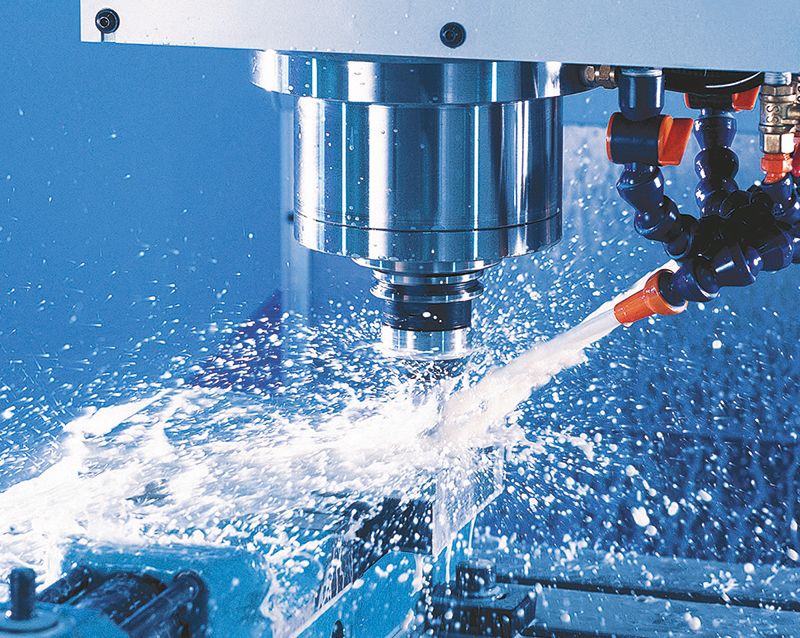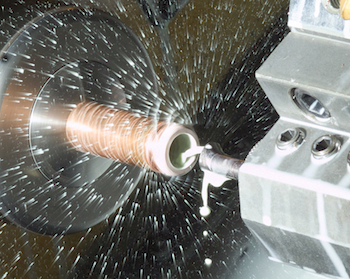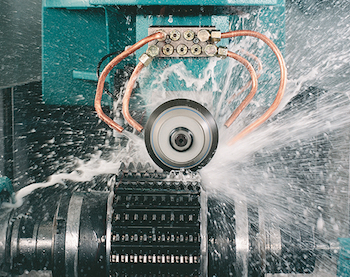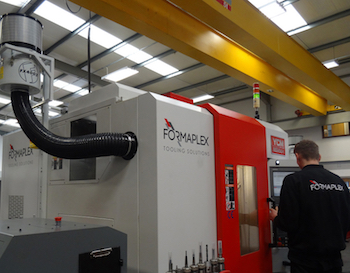Beside selecting the right coolant or cutting fluid for the material being machined, ensuring the fluid is kept clean for as long as possible is just as important, both for quality and cost saving

Machine shops using water-based metalworking fluids are being urged to initiate a regular system cleaning regime, amid fears that too many operators are short-changing their cleaning processes in order to reduce machine downtime. The warning is aimed specifically at machine shops using water-based coolants which are susceptible to bacterial growth that can severely impact the stability of a cutting fluid and its operational performance.
“The issue is that, all too often, operators do not understand the necessity of system cleaning, while their production directors are happy for them to shorten cleaning time in order to reduce overall machine downtime,” says Martyn Mann, technical director at Millers Oils. “Insufficient cleaning is merely storing up problems for a later date, because dirty fluid will inevitably contain debris and other contaminants, including bacteria which feed upon the fluid, reducing its effectiveness and ultimately impacting machine performance, tool life and finished workpiece quality.”
Regular monitoring and testing of metalworking fluid is recommended for both bacteria and pH value to ensure that the fluid remains in top condition, allied to a regular cleaning regime.

“Weekly checks, such as dip-slides or refractometers, will ensure that bacteria is kept under control and pH levels are at their optimum,” says Mann. “Low pH levels, for example, could be due to microbial contamination and ultimately lead to reduced corrosion protection. The introduction of a cleaning regime will eliminate many of the machining problems that operators face on a daily basis. Coolant systems need to be cleaned regularly in order to function properly and that means the sump, pipework, machine and guards, before re-filling with fresh metalworking fluid. Be careful to ensure that you are using a system cleaner compatible with the fluid, and don’t ever put clean fluid in a dirty machine or sump.”
To optimise the use of fluids in machining processes it is necessary to examine its journey from the beginning to the end of its lifecycle. This can be categorised into two distinct areas: in-process is the stage during which the fluid provides a vital function in support of machining, while end-of-pipe is the point at which the coolant is ready for disposal. Fluid optimisation can maximise the performance of the coolant in-process and also extend the end-of-pipe lifespan of the coolant through recycling.
Significant cost savings in recycling The recycling of coolant is of course a hot topic as it can lead to significant cost savings. However, the cleanliness issue here is more to do with separating the coolant from the chips and swarf to enable it to be reused. At Manx Engineers, based in the UK, the company has found a novel solution in the Wogaard Coolant Saver. This subcontract machinist supplies low-to-medium batches of automotive components, specifically smaller, precision-milled and turn-milled parts. To support this, the directors have recently invested in three new CNC machine tools: a Citizen A32 sliding head turn-mill centre; a Mazak Hyper Quadrex twin-spindle, twin-turret multi-tasking machine; and a Mazak Integrex mill-turn machine.
 Correct fluid management helps tool life, machine uptime and significant overall cost savings
Correct fluid management helps tool life, machine uptime and significant overall cost savingsThe neat oil coolant saver is fitted to the Citizen A32 which uses an expensive, low viscosity oil to cool the component and the cutting tools during machining. Installed by the company’s maintenance staff, the Wogaard unit has been operating for a few months. Primarily designed for the reclaiming of water miscible (soluble oil) coolant from machine tools with swarf conveyors, the scope of the coolant saver has now been extended to the recovery of neat oil from shops using sliding head machines.
“It is too early to calculate the exact savings, but it’s certainly paying for itself,” says company director Bob Ringham. “A barrel of neat coolant oil is an expensive necessity; if we can recover as much as possible from the swarf it makes good business sense and has positive implications for the environment as well.”
The parts conveyor on Citizen A32 takes the machined components away from the working envelope, and these tend to be smooth and are easily drained. As a result, the oil returns to the machine’s 220 litre sump without too much loss. However, the swarf conveyor also drags neat oil out with the chips and it is here that the coolant saver makes the most impact.
“As a subcontract machine shop we machine numerous different material types in line with customer specifications,” says Ringham. “Swarf is always segregated, making the extraction of neat oil coolant even more critical as the number of swarf bins with, say, half a litre of waste coolant would soon become overwhelming. Furthermore, all the staff have commented on the reduction in the number of sump top-ups required. Previously, we would add oil to the machine around three times per week, but we’ve now reduced this to once a week. So, the handling of the oil is reduced along with the chances of spilling it in transit or while trying to pour it into the machine’s tank, all of which improves our housekeeping. We are now looking to expand the use of the coolant saver to our other two Citizen sliding head lathes.”
Clearly, the automotive component machining industry is defined by its drive for innovation, encompassing increasingly complex machining processes, ground-breaking cutting tools and highly efficient machine tools. At the same time, the supply chain faces cost-down pressures, while minimising the impact on people and the environment wherever possible. Metalworking fluids are right in the centre of this conflict.
“From the perspective of a supplier of coolant recycling and management systems, we see all too often customers changing oil supplier to shave a few pence off a litre of product,” says James Byrom, managing director of Environmental Technologies, a UK company that offers the Cardev range of coolant mixing, handling and recycling systems, as well as Motorex cutting fluids.
“This is all well and good, but if nothing changes on the shop floor apart from the colour of the drums, there is little benefit for the business,” he adds. “We are constantly asked ‘how can we reduce our metalworking fluid spend?’ The straightforward answer is that the real savings come from managing a fluid properly, from the moment it leaves the barrel.” In short, what this means is accurate mixing, monitoring health and safety issues, the movement of product around the factory, and cleaning and recycling.
“The direct results of correct fluid management are increased tool life, improved machine uptime, reduced health and safety concerns, and happier and more productive operators, not to mention significant overall cost savings,” says Byrom. “Once the metalworking fluid is correctly managed, only then can the customer fully appreciate the real benefits of high quality fluid.”
 Centrifugal oil mist collectors provide efficient extraction across the variety of machining centres
Centrifugal oil mist collectors provide efficient extraction across the variety of machining centresAir quality within the shopAside from machine and component cleanliness, another issue of concern relating to the use of coolants and cutting fluids is air quality within the shop. A case in point can be seen at Havant, UK-based automotive manufacturing solutions company, Formaplex, which has benefitted significantly from a turnkey package supplied by filtration specialist, Filtermist.
Due to continued growth at Formaplex, investment in new CNC machinery also meant increased coolant usage. In order to meet demanding production deadlines, the company was running all its 18 CNC machines continuously. The oil mist within the facility had therefore increased, leaving traces of residue on the overhead gantry cranes, resulting in additional maintenance procedures being put in to place.
“Oil mist was starting to cause real concerns, especially on our high feed roughing applications,” explains Ben Yule, operations manager. Formaplex sought the assistance of Filtermist to provide oil mist extraction in the workplace. As a result of a full onsite assessment, it was agreed that Filtermist’s FX range of centrifugal oil mist collectors would provide the most efficient extraction across the variety of machining centres in use. A total of 14 oil mist extraction systems were installed, after which Formaplex noticed a significant improvement in air quality, reporting that there was no longer a haze across the roof of the facility, or traces of residue in the air or on the equipment.
“The introduction of the Filtermist units has successfully dealt with the issues we were facing, helping to create a clean and safe working environment for our employees, as well as keeping our facility operational around the clock,” concludes Yule.
For those who want to get ‘smart’ with their coolant and cutting fluid monitoring, apps such as CoolanTool from Quaker Chemical are available for the Apple and Android platforms. CoolanTool allows users to manage their cutting fluid data from anywhere in the plant using a smart phone. It facilitates the monitoring of metalworking fluids and the organisation of the data results in a number of ways. For instance, concentration and pH data results can be recorded, tracked graphically and shared among departments. Trends regarding the condition of the fluid can be analysed over extended periods of time to calculate consumption and top-up volumes. Furthermore, when combined with a proactive maintenance approach, CoolanTool helps optimise overall system performance. The app is available in English, Chinese and Russian.


































